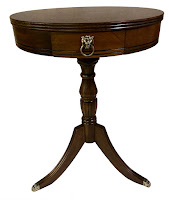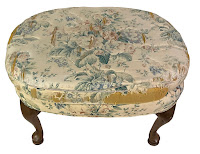 |
| Dining Chair After |
 |
| Dining Chair Before |
Unlike most of the other chairs I have worked on, these had a unique approach in how the fabric was attached to the cushion. After inspecting the bottom, I realized there were no screws holding in the seats. Everything was done from bottom up. Beneath the fabric was the Dacron; beneath the Dacron was the foam and underneath everything was the webbing.
The material had been attached by staples at the base of the seat's top, covered up with double welt cording. In most dining room chairs the seat is removed by unscrewing it from the base, so each seat can be worked on independently of the chair. The advantage is that you have access to the entire seat and can work on a tabletop. For this particular chair, that was not the case. Everything had to be removed and reassembled right on the chair. This leaves little to no room for error (not that that ever happens...lol). Once I established how these seats were put together, I proceeded to yank off the old welt cording, then removed staples, lots and lots of staples at the base of the seat, surrounding the entire chair.
Because these chairs needed new cushions, I removed the old Dacron and cushions and replaced them with new high density foam. I also reinforced the old webbing by adding some new webbing strips to give the bottom extra firmness and support. The old webbing was likely original, narrow and a little sloppy. I used three inch jute webbing, which provides a stronger, more stable seat. For the cushions, I used the old cushions for size and shape, then cut the new ones and aligned them on the webbing, then secured them with staples on the bottom edge.
New Dacron covered the foam and then the chairs were ready for new new fabric. Slow is pro, so I took my time and made sure the material covered the chair enough to allow for the staples without covering the lip of the seat. The final step was gluing the double welt cording to the bottom edge which covers the staples while providing an elegant finishing touch to the seats. Two of the chairs required a replacement of the chambray dust cover, so once those were done, my project was complete.
 |
| Dining Chair Before/After |































